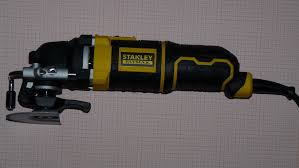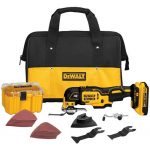Last Updated on March 14, 2021 by James
An oscillating tool is also known as an oscillating multi-tool. The built up of an oscillating tool resembles a grinder body which has varying diameters. However the major difference in the various kinds of oscillating tool lies in its head. Some of them have a mechanism which clamps itself to the head of the tool for use. The name oscillating tool comes from the fact that it oscillates back and forth innumerable times in a single minute. A high end model oscillating tool will oscillate at a speed of 18000-20000 OPM (oscillations per minute).

An oscillating tool is one of the most versatile handheld power tools, and it is compact in its size and can easily be operated, even if it be in the tightest spaces where most tools might not reach. You can easily attach a wide variety of attachments to it making this dynamic tool even more efficient at completing a number of projects. These are the few reasons why an oscillating tool is a must have power tool for professionals and DIYers.
What Is An Oscillating Tool Used For?
There is a reason why oscillating tools are also called multi-tools. A lot of professionals and DIYers use the blade of the tool to cut through wood, metal, PVC or any other form of material. It is also used for specifically scraping out silicon, grout or any form of adhesives. However it is not just the blade which is its most important attachment. All form of oscillating tools come with a sanding head which is shaped as a triangle having several sanding pads.
Even though an oscillating multi-tool can cut, scrap and sand – it is not really its best applications. You could even use a reciprocating saw to cut more accurately and quickly, or a grinder to remove adhesives more effectively or a delta pad finish to sand corners. So an oscillating tool can be more effective in a space where the primary tools will not be able to fit in or will be difficult to use. For instance, it is great for undercutting baseboards which are flushed to the floor or for even cutting pipes which are in tighter spaces. The use of an oscillating tool in such spaces will help you in giving better control over the fixtures or finished tiles especially if you are removing adhesives.
What Should You Look For In An Oscillating Tool?
When it comes to the feature sets, an oscillating multi-tool is pretty basic but here are a few things you need to look out for in this tool when you plan to buy one for yourself:
1. Accessory Change: At times changing accessory can be a very simple task and at other times, it could be a difficult task. So check for a model which will require you to change the blade less often and is easy to use when it comes to fitting in accessories and attachments.
2. Accessory Type: Be aware of the accessories the oscillating tool will require and what style you are more comfortable using. For example, a model of Starlock will not work with a regular blade, while a Festool has a distinct proprietary system of its own.
3. Rate of Oscillation: The higher is the top speed or the rate of oscillation, the faster will the tool be able to cut through the material. You should ideally look for somewhere between 18000 to 20000 OPM.
4. Angle of Oscillation: The higher is the angle of oscillation, the more accurate as well as aggressive will the cuts be. This implies higher level of speed but also more noise and vibration. Mostly, 3.6 to 3.7 degrees which means approximately 1.8 degrees on either sides is a well maintained balance.
5. Vibration: The more vibration the oscillating tool will have, the lower will be its comfort level while usage. In this category, Fein is a top-end model as it eliminates vibration to a considerable extent.
6. Variable Speed Dial or Trigger: Usually, an oscillating tool which has an ON/OFF switch and a variable speed dial is the preferred option among most. However there are others which comes in paddle trigger styles. So in case you are looking for one with this style, go for the ones which have a lock on the switch which will be really helpful for sanding and scraping.
What Motion Does An Oscillating Tool Have?
The motion of an oscillating tool is incredibly fast, something that you will not be able to detect with your naked eyes. You will feel the vibration in your hands when it will be in use. This high speed motion is, however, ideal for making quick fixes and cutting a wide variety of materials, whilst maintaining a smooth performance and delivering reliable control over the tool.
Conclusion
Aforementioned, an oscillating tool is ideal for sanding wood, fillers, and hard finishes very smoothly. You can easily take up more than one project at a time as it is capable of providing great speed with accuracy. If you have the right attachments for your oscillating tool you can easily grind, remove adhesives, make flush and cut metal and pipings even in tighter spaces with great ease. An oscillating tool is a must-have powerful tool which is used both at home and in workspace. Apart from these factors, it is compact, lightweight and ideally accepts a wide variety of attachments for versatility of use.
